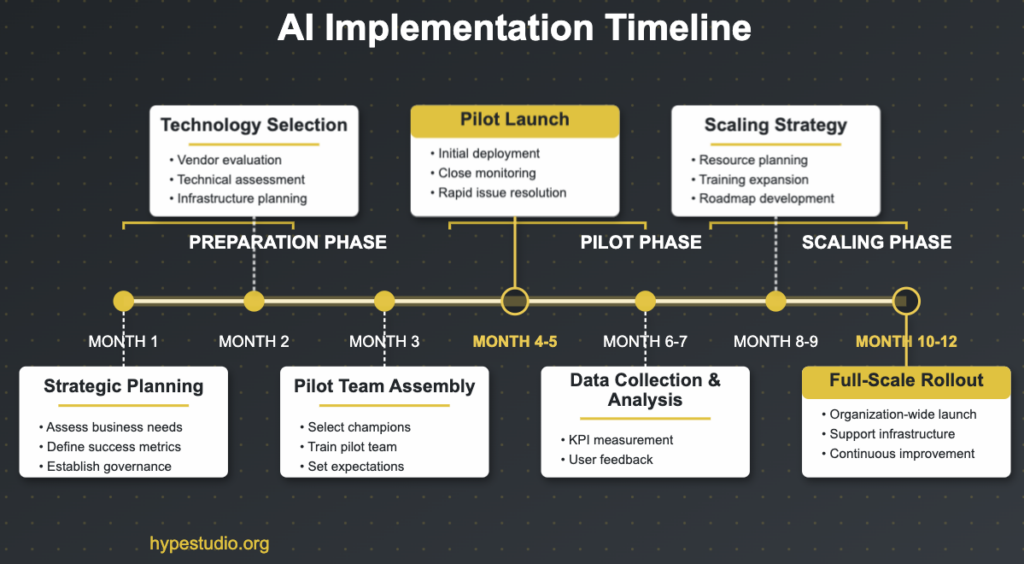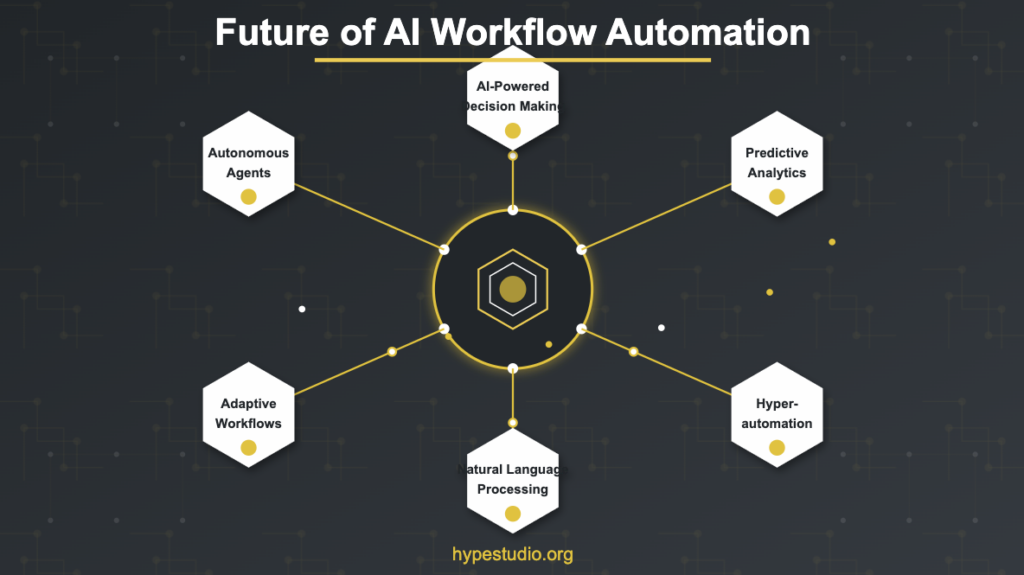Crafting a custom AI workflow isn’t just about adopting the latest technology—it’s about designing a system that aligns seamlessly with your business goals, integrates with existing processes, and scales as you grow. For decision-makers leading digital transformation, the stakes are high: efficiency, accuracy, and competitive edge are all on the line.
But where do you begin? From identifying strategic objectives to ensuring smooth integration and ROI measurement, every step matters. A well-executed custom AI workflow can optimize productivity and free up critical resources, but success requires careful planning and execution.
Let’s break down the essential strategies and best practices that will empower you to design, implement, and refine a custom AI workflow tailored to your organization’s unique needs, showing how to turn potential into transformative results.
Key Takeaways
- Strategic Planning: Successful custom AI workflows begin with clear business objectives and process mapping, ensuring alignment with organizational goals before implementation.
- Integration Capabilities: Custom AI workflows must seamlessly connect with existing business systems and processes, requiring careful consideration of compatibility and data flow management.
- Scalability Requirements: Design workflows to accommodate business growth and changing needs, focusing on flexible architecture that can evolve with increasing demands and complexity.
- Implementation Approach: Start with pilot programs in non-critical areas before full deployment, allowing for testing and refinement of the workflow design while minimizing risk.
- Change Management: Success depends heavily on effective employee training and communication strategies to ensure smooth adoption and maximize workflow effectiveness.
- ROI Measurement: Establish clear metrics and monitoring systems to track workflow performance and demonstrate business value through quantifiable results.
- Security Considerations: Incorporate robust data protection measures and compliance protocols throughout the workflow design and implementation process.
- Automation Optimization: Regular assessment and refinement of workflows ensure continued efficiency and effectiveness as business needs evolve.
- Technology Selection: Choose AI tools and platforms based on specific business requirements, technical capabilities, and long-term scalability needs.
Custom AI workflows represent a transformative approach to business process automation, combining artificial intelligence capabilities with tailored process design to address specific organizational needs. These workflows automate complex business processes by leveraging AI technologies like machine learning, natural language processing, and computer vision to handle tasks that previously required human intervention. Custom AI workflow solutions differ from standard automation by incorporating intelligence, adaptability, and learning capabilities that evolve with your business requirements.
Understanding Custom AI Workflows

A custom AI workflow is an intelligent process automation system specifically designed to meet unique business requirements through the application of artificial intelligence technologies. Unlike generic automation tools, AI workflow automation incorporates machine learning algorithms, natural language processing, and predictive analytics to create dynamic systems that can make decisions, learn from data, and adapt to changing conditions.
The significance of these workflows lies in their ability to transform operations beyond simple task automation. They can analyze complex data sets, recognize patterns, make predictions, and execute actions based on sophisticated decision-making processes. This intelligence enables businesses to automate processes that were previously considered too complex or nuanced for traditional automation.
The impact on operational efficiency is substantial. Organizations implementing custom AI workflows report productivity increases of 30-50% in targeted processes, with corresponding reductions in operational costs. More importantly, these systems free human workers from repetitive tasks, allowing them to focus on creative, strategic, and high-value activities that drive innovation and growth.
A manufacturing company implemented a custom AI workflow to optimize their quality control process, resulting in a 45% reduction in defects and saving over $2 million annually in warranty claims and rework costs.
Strategic Planning for AI Workflows
Effective implementation of custom AI workflow solutions begins with clear business objectives. Organizations must identify specific operational challenges, performance gaps, or strategic opportunities that AI can address. These objectives should be specific, measurable, and aligned with broader organizational goals to provide direction and purpose for the workflow design.
When setting objectives, consider both immediate operational improvements and long-term strategic advantages. For example, an immediate goal might be reducing processing time for customer inquiries by 40%, while a strategic objective could be developing predictive capabilities to anticipate customer needs and enhance satisfaction.
Process mapping serves as the foundation for effective workflow design. This involves documenting current processes in detail, identifying inefficiencies, decision points, and opportunities for enhancement. Thorough process analysis reveals which aspects would benefit most from AI capabilities and which should remain human-centered.
The mapping exercise should capture not only the sequence of activities but also the data inputs, outputs, decision criteria, and exceptions that characterize the process. This comprehensive understanding enables designers to create workflows that address real operational needs rather than implementing technology for its own sake.
Process Mapping Techniques
Several methodologies can facilitate effective process mapping for AI workflow design:
- Value Stream Mapping to identify value-adding and non-value-adding activities
- Business Process Model and Notation (BPMN) for standardized visual representation
- Swim lane diagrams to clarify roles and responsibilities
- Decision trees to document complex decision-making logic
Integration Capabilities and System Compatibility
Successful AI-powered productivity systems must seamlessly connect with existing enterprise architecture. This integration requires careful assessment of current systems, data sources, and technological infrastructure. Key integration requirements include API compatibility, data format standardization, authentication mechanisms, and communication protocols that enable smooth information flow between the AI workflow and other business systems.
Organizations typically need to integrate with multiple systems, including:
- Enterprise Resource Planning (ERP) systems
- Customer Relationship Management (CRM) platforms
- Content Management Systems (CMS)
- Legacy databases and applications
- Cloud services and third-party tools
Data flow management presents significant challenges in integration efforts. Organizations must address issues of data quality, consistency, and timeliness to ensure the AI workflow receives accurate inputs and delivers reliable outputs. Effective data governance frameworks are essential to maintain data integrity throughout the workflow.
System compatibility challenges often arise when connecting modern AI capabilities with legacy systems. These can be addressed through middleware solutions, custom APIs, or data transformation services that bridge technological gaps. In some cases, organizations may need to implement data lakes or warehouses to consolidate information from disparate sources before feeding it into AI workflows.
A financial services firm reduced manual data entry by 85% after implementing a custom AI workflow that integrated with their legacy banking systems, modern CRM, and regulatory compliance databases.
Scalability in AI Workflow Design
Creating scalable AI workflows requires forward-thinking design that accommodates future growth and evolving business requirements. Scalability encompasses both the ability to handle increasing volumes of transactions or data and the flexibility to adapt to new business processes, user needs, and technological advancements.
Designing for flexibility involves creating modular workflow components that can be reconfigured or extended without disrupting the entire system. This modular approach allows organizations to add new capabilities, modify existing functions, or integrate additional systems as business needs evolve. Containerization technologies and microservices architectures support this flexibility by encapsulating workflow components as independent, interchangeable units.
Building a scalable architecture requires attention to several key elements:
- Horizontal scaling capabilities to add processing capacity as demand increases
- Load balancing to distribute work evenly across available resources
- Asynchronous processing for handling variable workloads
- Caching strategies to optimize performance
- Database design that accommodates growing data volumes
Cloud-based implementations offer particular advantages for scalability, allowing organizations to adjust computing resources dynamically based on actual usage patterns. This elasticity enables custom AI agents to maintain performance during peak periods without requiring permanent infrastructure investments.
Performance considerations should be addressed early in the design process, with attention to potential bottlenecks, resource requirements, and optimization opportunities. Regular performance testing under various load scenarios helps identify scaling limitations before they impact business operations.
Implementation Strategy: Pilot Programs

Starting with pilot programs represents a prudent approach to AI workflow automation implementation. These controlled deployments allow organizations to test workflow designs, validate assumptions, and identify potential issues before committing to full-scale implementation. Strategic pilot selection involves choosing processes that are important enough to demonstrate value but not so critical that failures would disrupt core business operations.
Ideal candidates for pilot programs include:
- Processes with clear boundaries and measurable outcomes
- Workflows with moderate complexity that showcase AI capabilities
- Operations with supportive stakeholders willing to provide feedback
- Areas where quick wins can build momentum for broader adoption
The testing and refinement phase is critical for success. Organizations should establish clear evaluation criteria, collect both quantitative performance metrics and qualitative user feedback, and maintain an iterative improvement cycle. This phase often reveals unexpected challenges or opportunities that weren’t apparent during the design stage.
Pilot programs also serve as valuable learning experiences for the implementation team, building capabilities and knowledge that will benefit subsequent deployments. They provide opportunities to refine change management approaches, technical implementation methods, and user training strategies before scaling to the entire organization.
Risk mitigation is a key benefit of the pilot approach. By identifying and addressing issues in a controlled environment, organizations can prevent more costly problems during full deployment. Common risks that pilots help mitigate include user adoption challenges, performance issues, integration complications, and unexpected process exceptions.
Change Management and Employee Adoption
The technical excellence of a custom AI workflow means little without effective user adoption. Change management strategies play a crucial role in helping employees transition from established processes to new AI-enhanced workflows. This transition requires addressing both practical skill development and psychological factors like resistance to change and fear of job displacement.
Training programs should be comprehensive yet accessible, covering both the technical aspects of using the new system and the conceptual understanding of how AI enhances work processes. Effective training approaches include:
- Role-based training tailored to specific user needs
- Hands-on practice with realistic scenarios
- Just-in-time learning resources are available at the point of need
- Peer learning networks that leverage internal champions
- Continuous learning opportunities as the system evolves
Communication strategies should begin early in the implementation process and continue well beyond the initial deployment. Transparent communication about the purpose, benefits, and timeline of the AI workflow helps build trust and reduce uncertainty. Messages should address both organizational benefits and personal advantages for employees, emphasizing how AI will enhance their work rather than replace it.
Involving employees in the design and implementation process increases ownership and acceptance. User feedback mechanisms, pilot participant selection, and change ambassador programs all provide opportunities for meaningful involvement that improve both the technical solution and its adoption.
A healthcare provider achieved 94% user adoption of their new AI-powered clinical documentation workflow by implementing a peer mentor program where experienced users provided personalized support to colleagues during the transition period.
Measuring ROI and Workflow Performance
Demonstrating the business value of custom AI solutions requires robust measurement frameworks that capture both direct financial returns and broader organizational benefits. Establishing clear metrics before implementation provides a baseline for comparison and helps focus the workflow design on outcomes that matter to the business.
Key performance indicators for AI workflows typically fall into several categories:
- Efficiency metrics: processing time, throughput, resource utilization
- Quality measures: error rates, accuracy, consistency
- Financial indicators: cost savings, revenue impact, return on investment
- User experience: satisfaction scores, adoption rates, support requests
- Strategic outcomes: innovation capacity, competitive advantage, market responsiveness
Monitoring systems should provide real-time visibility into workflow performance, enabling proactive management and continuous improvement. Performance dashboards with drill-down capabilities allow stakeholders at different organizational levels to access relevant insights, from operational details to executive summaries.
ROI analysis for AI workflows should consider both tangible and intangible benefits. While cost savings from reduced manual effort are relatively straightforward to calculate, other benefits like improved decision quality, enhanced customer experience, or increased organizational agility may require more sophisticated valuation approaches.
The time horizon for ROI evaluation should match the strategic nature of AI investments. While some benefits appear quickly, others develop over time as the system learns and improves, or as users become more proficient. A comprehensive evaluation framework accounts for both immediate returns and long-term value creation.
Security and Compliance in Workflow Design
Security considerations must be integrated throughout the AI workflow automation lifecycle, from initial design to ongoing operations. This security-by-design approach addresses potential vulnerabilities before they can be exploited and builds protection into the core of the workflow rather than adding it as an afterthought.
Key security measures for AI workflows include:
- Data encryption both in transit and at rest
- Strong authentication and authorization controls
- Secure API management
- Regular security assessments and penetration testing
- Monitoring for unusual patterns or potential breaches
- Secure development practices for custom components
Compliance requirements vary by industry and geography but typically address data protection, privacy, record-keeping, and process validation. Regulatory frameworks like GDPR, HIPAA, SOX, or industry-specific regulations impose specific obligations that must be reflected in workflow design and operation.
AI workflows present unique compliance challenges related to algorithmic transparency, bias prevention, and decision auditability. Organizations must implement appropriate governance mechanisms to ensure AI components operate within ethical and regulatory boundaries. This may include explainability features that document how AI reaches specific conclusions or recommendations.
Documentation and audit trails are essential for both security and compliance purposes. Workflows should maintain comprehensive logs of system activities, data access, and decision processes to support incident investigation, compliance verification, and continuous improvement efforts.
A financial institution implemented a custom AI workflow for fraud detection that reduced false positives by 60% while maintaining full compliance with anti-money laundering regulations through comprehensive audit trails and explainable AI techniques.
Continuous Optimization of AI Workflows
The implementation of a custom AI workflow marks the beginning rather than the end of the optimization journey. Continuous improvement processes ensure the workflow remains effective, efficient, and aligned with evolving business needs. Regular assessment cycles should evaluate performance against established metrics, identify improvement opportunities, and prioritize enhancements based on business impact.
Feedback mechanisms from multiple sources provide valuable insights for optimization:
- User feedback on usability and functionality
- Performance data showing efficiency and effectiveness
- Exception reports highlighting process breakdowns
- Business stakeholder input on changing requirements
- Technical monitoring of system health and resource utilization
Machine learning components within AI workflows offer unique optimization opportunities through ongoing training and refinement. As these components process more data, they can improve their accuracy, speed, and decision quality. Performance monitoring should track these improvements and identify areas where additional training or algorithm adjustments would be beneficial.
Adapting to evolving business needs requires both technical flexibility and organizational processes that capture and prioritize change requirements. Governance structures should balance the need for stability with the imperative for continuous improvement, establishing clear pathways for implementing enhancements while maintaining system integrity.
Version management becomes increasingly important as workflows evolve. Organizations should maintain comprehensive documentation of workflow versions, including the rationale for changes, performance impacts, and compatibility considerations. This documentation supports both operational management and compliance requirements.
Choosing the Right Tools and Technologies
Selecting appropriate technologies for AI process automation requires careful evaluation of business requirements, technical capabilities, and strategic considerations. The technology landscape for custom AI agents includes a wide range of options, from specialized AI platforms to general-purpose development tools and industry-specific solutions.
Key selection criteria should include:
- Alignment with specific business requirements and use cases
- Integration capabilities with existing systems and data sources
- Scalability to accommodate growth and changing demands
- Security features and compliance certifications
- Total cost of ownership, including licensing, implementation, and maintenance
- Vendor stability, support quality, and product roadmap
- Technical compatibility with organizational skills and infrastructure
The evaluation process should involve multiple stakeholders, including business users, IT specialists, security experts, and strategic decision-makers. Proof-of-concept projects with shortlisted technologies can provide valuable insights into their practical capabilities and limitations before making significant commitments.
Organizations must also consider the build-versus-buy decision for different workflow components. While some elements may require custom development to address unique requirements, others might be more efficiently implemented using commercial platforms or services. Hybrid approaches often provide the optimal balance between customization and implementation efficiency.
Long-term scalability assessment should look beyond current requirements to anticipate future needs. This forward-looking evaluation considers factors like expected growth in transaction volumes, potential expansion to new business areas, and emerging technologies that might enhance or disrupt current approaches.
Addressing Challenges in Custom AI Workflow Implementation
Implementing AI-powered productivity systems involves navigating various challenges that can impact project success. Understanding these challenges and developing proactive strategies to address them significantly improves implementation outcomes.
Common adoption challenges include:
- Resistance to change from employees who are comfortable with existing processes
- Unrealistic expectations about AI capabilities and limitations
- Data quality issues that affect workflow performance
- Integration complexities with legacy systems
- Skill gaps in both implementation and operational teams
- Difficulty demonstrating value, particularly for intangible benefits
Legacy system integration presents particular difficulties for many organizations. These systems often lack modern APIs, have limited documentation, and use outdated data formats that complicate connection with AI workflows. Integration strategies may include middleware solutions, data extraction layers, or phased replacement approaches that gradually transition functionality to new systems.
Addressing skill gaps requires both short-term and long-term strategies. In the short term, organizations may leverage external expertise through consultants or managed services to supplement internal capabilities. Long-term approaches focus on building internal competencies through hiring, training, and knowledge transfer programs.
Regulatory considerations vary by industry but commonly include data privacy requirements, process validation obligations, and documentation standards. Organizations should engage compliance experts early in the design process to ensure workflows meet all applicable requirements without compromising efficiency or effectiveness.
A retail organization overcame integration challenges with its 20-year-old inventory system by implementing a data abstraction layer that standardized information flow between the legacy system and its new AI-powered demand forecasting workflow.
Best Practices for Implementing Custom AI Workflows
Successful implementation of custom AI solutions follows established best practices that address both technical and organizational aspects of the project. These practices help organizations maximize value while minimizing risks throughout the workflow lifecycle.
Key design practices include:
- Starting with clear business objectives rather than technology-driven goals
- Involving end users throughout the design process
- Creating modular architectures that support flexibility and reuse
- Implementing robust error handling and exception management
- Designing for observability with comprehensive logging and monitoring
- Building in security and compliance from the beginning
Implementation best practices focus on managing change effectively:
- Using iterative approaches that deliver incremental value
- Establishing clear governance structures and decision processes
- Providing comprehensive training and support resources
- Communicating consistently about progress, challenges, and successes
- Measuring and sharing results to build momentum
Optimization practices ensure continued value creation:
- Establishing regular review cycles to assess performance
- Creating feedback channels for users and stakeholders
- Monitoring technological developments for enhancement opportunities
- Documenting lessons learned to improve future implementations
- Balancing stability with continuous improvement
Common pitfalls to avoid include underestimating change management requirements, focusing on technology rather than business outcomes, neglecting data quality issues, and failing to establish clear success metrics. Organizations should also avoid the temptation to automate broken processes without first optimizing them for efficiency and effectiveness.
Successful case studies demonstrate the transformative potential of well-implemented AI workflows. For example, a healthcare provider reduced insurance claim processing time by 75% while improving accuracy by implementing a custom AI workflow that automated document analysis, coding validation, and submission processes.
Future Trends in Custom AI Workflows

The landscape of custom AI workflow solutions continues to evolve rapidly, with several emerging trends shaping future capabilities and applications. Organizations should monitor these developments to identify opportunities for competitive advantage and prepare for changing technology paradigms.
Hyper-personalized AI assistants represent a significant advancement in workflow automation. These systems go beyond generic process automation to provide contextually aware support tailored to individual user preferences, work patterns, and skill levels. They adapt their behavior based on ongoing interactions, becoming increasingly effective as they learn from user feedback and behavior patterns.
Cross-platform workflow integration is breaking down silos between applications and environments. Future workflows will seamlessly span cloud services, on-premises systems, mobile devices, and edge computing platforms, creating unified experiences regardless of where users or data reside. Integration standards and middleware solutions are evolving to support this connectivity without requiring custom development for each interface.
No-code AI development tools are democratizing workflow creation, allowing business users to design and implement AI-enhanced processes without extensive technical expertise. These platforms provide visual design interfaces, pre-built AI components, and simplified integration capabilities that reduce dependence on specialized development resources and accelerate implementation timelines.
Ethical AI governance frameworks are becoming essential as organizations recognize the importance of responsible AI deployment. These frameworks address issues like algorithmic bias, decision transparency, privacy protection, and appropriate human oversight. Future workflow implementations will incorporate these considerations by design rather than as afterthoughts.
Edge-based workflow processing moves AI capabilities closer to data sources, enabling faster response times, reduced bandwidth requirements, and enhanced privacy protection. This approach is particularly valuable for applications with latency-sensitive requirements or those operating in environments with limited connectivity.
A telecommunications company is pioneering edge-based AI workflows that analyze network performance data locally at cell towers, enabling real-time optimization that has improved connection stability by 35% while reducing backhaul bandwidth requirements by over 60%.
Conclusion
Custom AI workflows represent a powerful approach to business transformation, combining the efficiency of automation with the intelligence and adaptability of artificial intelligence. When properly designed and implemented, these workflows deliver significant improvements in operational efficiency, decision quality, and customer experience while freeing human talent for higher-value activities.
The journey to successful implementation requires careful planning, stakeholder engagement, and attention to both technical and organizational factors. Organizations that follow best practices for design, implementation, and optimization position themselves to realize substantial returns on their AI investments while building capabilities for ongoing innovation.
As AI technologies continue to advance, the potential applications and benefits of custom workflows will expand accordingly. Organizations that establish strong foundations now, through thoughtful strategy, appropriate technology choices, and effective change management, will be well-positioned to leverage these future capabilities for competitive advantage.
Ready to explore how custom AI workflows can transform your business operations? Contact our team of experts to discuss your specific challenges and opportunities, and discover how tailored AI solutions can help you achieve your strategic objectives.
References
Frequently Asked Questions
Q: How Do I Create an AI Workflow?
Creating an AI workflow is like building a symphony, where each note (or task) harmonizes to produce a masterpiece of automation. By integrating AI into your workflows, you can streamline processes, enhance productivity, and improve decision-making. Here are key aspects of creating an AI workflow:
– Automation Tools: Utilize AI-powered tools to automate repetitive tasks and enable more strategic work.
– Workflow Optimization: Identify bottlenecks in existing workflows and improve efficiency by leveraging AI’s analytical capabilities.
– Integration: Seamlessly integrate AI with existing systems to enhance data processing and interpretation.
– Continuous Monitoring: Regularly monitor and adjust workflows to maintain optimal performance.
According to experts, AI workflow automation can improve efficiency by up to 90%, making it a game-changer for businesses[4].
Q: How Much Does a Custom AI Cost?
Crafting a custom AI solution is akin to tailoring a bespoke suit – it fits perfectly but can come at a price. The cost depends on the complexity, scope, and technology involved. Here are some insights:
– Complexity and Scope: Prices vary significantly based on whether you are building a simple chatbot or a complex predictive model.
– Technology Stack: The choice of frameworks and tools can impact costs, with proprietary solutions often being more expensive than open-source alternatives.
– Development Time: The longer the development time, the higher the cost, especially if you’re hiring experts.
– Maintenance and Updates: Ongoing maintenance and updates can add to the initial cost, but are essential for keeping the AI system relevant.
For instance, custom AI projects typically range from tens of thousands to hundreds of thousands of dollars, depending on the specific requirements and technologies used.
Q: How Do I Create an AI Agent Workflow?
Building an AI agent workflow is like designing a high-performance vehicle – it requires precision and strategic planning. AI agents can automate tasks, engage customers, or analyze data, making them versatile tools. Here’s how you can create one:
– Define Objectives: Clearly outline what you want your AI agent to accomplish, whether it’s customer service, data analysis, or process automation.
– Agent Design: Design the agent’s architecture, including the type of AI model and data it will use.
– Integration with Systems: Integrate the agent with existing systems to leverage existing data and functionality.
– Continuous Improvement: Regularly update and improve the agent based on performance data and user feedback.
Using Azure AI Language, you can develop AI agents that handle custom questions, providing personalized responses to users[5].
Q: How Do I Create a Custom AI?
Creating a custom AI is like crafting a masterpiece – it requires creativity, precision, and a deep understanding of what you’re trying to achieve. Here are some key steps:
– Define Your Needs: Identify the specific problem or area where you want AI to make a difference, whether it’s improving customer interactions or optimizing business processes.
– Select Technologies: Choose the right AI technologies and frameworks that align with your goals, such as machine learning for predictive tasks or natural language processing for chatbots.
– Develop and Train Models: Develop and train AI models using relevant data to ensure they can perform their intended tasks effectively.
– Deploy and Monitor: Deploy your AI solution and continuously monitor its performance to make necessary adjustments.
For example, AI-powered SEO content generation can save businesses thousands of hours in content creation annually by automating the process.
Any Other Questions?
That wraps up the most popular questions we get, but fire away with any others!
Contact us to discuss your next development project!
FAQ References
– https://www.bizway.io/blog/ai-workflow-automation-examples
– https://document360.com/blog/ai-prompts-for-creating-faqs/
– https://www.copy.ai/workflows/document-to-faqs
– https://www.calendar.com/blog/custom-ai-workflows-how-to-design-your-own-productivity-system/
– https://learn.microsoft.com/en-ie/answers/questions/2100210/faq-bot-using-conversational-language-workflow


